What is a sweat lodge? Why would I want to try one? How are these things made? What goes on inside? It’s funny for me to think that just six years ago I would not have thought I would be the one who could answer these questions from firsthand experience!
The first time I’d ever encountered the concept of a sweat lodge was watching a movie with my teen son called “Crooked Arrows” – about a Native American lacrosse team that went from losers to winners. As part of the team building process, they went into a sweat lodge and came out with spirit animals and a drive to win. My son and I liked this part so much, we thought we would try to find a sweat lodge to gain visions and motivation. At the time, the only person I knew who knew anything about them, was all the way up in Maine (easily an eight-hour drive for us.) With his lacrosse matches taking up our time, we didn’t follow up. But we did remain curious about this Native American ritual.

If you want to watch the “Crooked Arrows” movie, click the photo. (I have an Amazon Affiliate, so if you buy something through this link I may make a profit. Not much, but I want to be transparent).
WHAT IS A SWEAT LODGE?
The scene from the movie didn’t explain much to me. It looked like a small covered dome where the boys all crawled in, and when they came out hours later, were spiritually energized. Huh? It all seemed so mystical.
The term sweat lodge refers to the physical structure as well as the Native American ceremony. The physical structure is a small, covered dome with a pit in the middle. Red hot rocks are placed in the pit. When the participants are all inside, the door is closed over and the leader pours water on the rocks to create steam. It gets hot inside, causing people to sweat. People have asked me if I mind the heat. Having practiced Bikram Yoga for over 15 years, I don’t mind it. That level of sweating feels cleansing to me.
Which leads me to the ceremony. They are called “Inipi” (literally translating Ini – to breathe, and pi, which is from tipi, – lodge), “purification ceremonies” or, often just referred to as a sweat. The ceremony aims is to be spiritually, mentally, emotionally and physically healing. The sweat helps bring out toxins – purifying the body. The uncomfortable heat helps shift the mindset and allows you to be open to spirit (if you don’t believe in Creator, God, or whatever, it opens you to your own heart messages.) In this sense, you are purifying your spirit. From what I’ve seen, it’s also an honored way to connect with the earth as well as the community.

The sun setting behind the covered sweat lodge. The bottles contain water for use on the red hot stones. The shed in the background are where the blankets are stored when the lodge is not in use.
Let me take a quick aside – people who lead these ceremonies are usually trained for several (4+) years in all aspects. Not just how to build them, or spiritually lead them, but also to make sure that safety precautions are met. If you have heart issues or are pregnant, you may want to not consider doing this. In some sweats I’ve been in, children have been allowed…but constantly asked if they’re ok. Most kids cannot make it the entire time, and they are respected for leaving. The ones I’ve gone to have all been led by a man who has been conducting them for many years (we call him Chief, as he leads us as his varied-background “tribe”).
HOW ARE THEY MADE?
The first time I saw a photo of a sweat lodge structure (without a cover), I couldn’t help but wonder how people could fit inside (it’s so short) and how does it keep from burning (I didn’t know how the sauna effect was created). Without knowing the artistry involved in making the Inipi, I thought it looked similar to a kid-created tree fort.

This is the first real-life sweat lodge structure I encountered. It had been sitting out all winter, and needed to be prepared for use.
The ceremony, so I’ve been told, starts with the building of the sweat lodge. While they don’t build new structures for every sweat (they can last for years if taken care of properly), the building of it follows traditions. The land is first blessed with an offering of tobacco. Tobacco is a medicine plant, and used in many rituals in many forms. The lodge is built from trees and shaped into a curved dome and sits on flat dirt.

Young saplings are sustainably and honorably harvested. Each tree that is cut down is given a blessing of thanks for it’s service for the ceremonies.They are often tied with pieces of cloth, with each color representing the four elements. East is yellow, South is white, West is black and North is red. The colors also have symbolisms associated with them, but these can vary with different tribes. Symbolisms such as yellow = enlightenment, white = innocence, black = common sense, and red = courage.
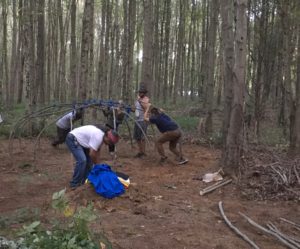
Sweat lodges have a specific pattern to them, involving 16 poles, or young saplings, bent and tied together. Notice the material that will be torn into strips and used to tie the poles together, the colors used dependent on the elemental direction.

This is the view from the fire pit in a sweat lodge looking up. The way the poles/trees are put together end up with this pattern. Once the structure is covered you won’t see this star, but you know it’s there – a symbolic connection to the heavens.
The pit is in the center, with room around it for people to be able to sit. Some lodges hold up to 20 or so people. I like them better when there are not so many people, so that when it gets too hot I can lay down on the cool earth. The structure is covered with blankets, with a small entrance opening. The entrance faces East. The blankets not only help keep the heat in, it also completely blocks out the light (the doorway gets covered after everyone is inside). Crawling into the small, moist, hot space is representative of passing the womb of Mother Earth. Coming out that passageway, all sweaty and feeling uplifted, can feel somewhat like a rebirth.

While in Costa Rica, we came across this one – which has flowers growing on it!
Opposite the sweat lodge door is the area where the sacred fire is built for the heating of the stones. The fire is built in a specific format, and usually by specially trained ‘fire keepers’. The first four logs are placed east to west, and the second four logs north to south. Rocks are placed in these fires. The more rocks, the longer the sweats will take (they can last for hours, depending on what the ceremony is for – community building, spiritual healings, preparations for Vision Quests, to honor a member, or even help people with their addictions.) The rocks are known as “Grandfather” to represent the spirits that live within them (Native Americans believe all living things have spirits, and the stone people are here to help us in this lifetime). After the stones are done being used in the lodges, they are placed on the edges of the sacred fire pit, as a sort of wall. I’ve noticed I can tell a sweat lodge has been used often by the size of this wall.
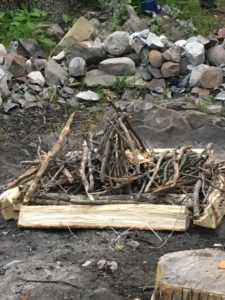
Notice the layout of the base of the sacred fire?
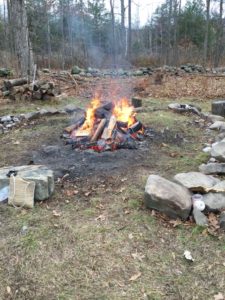
Heating up the rocks can take hours (the ones chosen are in the fire. The used ones surround the outside edge of the fire pit).
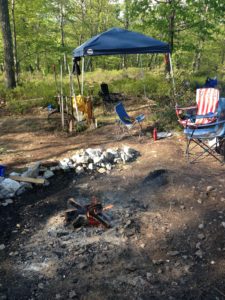
Post sweat lodge ceremony. You can see where the used stones are placed around the fire’s edges. The road behind the pop-up tent leads to our camping area.
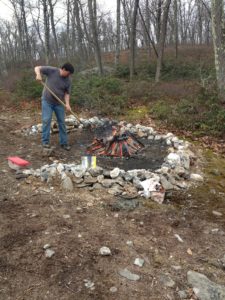
Learning to be a fire keeper takes time. Over the course of a weekend, several Native Americans shared their wealth of knowledge from care of fire vs how to tend a sacred fire, to in-depth history on Grandfather, the stone people.
In the middle of this meridian aligned with east/west points lays the sacred alter. This is not the place to safeguard your wallet, or keys, or random jewelry. This is the area where objects of spiritual value are placed, and benefit from the energy of the sweat lodge. Chief, the leader of our group, always places a special Buffalo skull here, along with other items of special meaning to him. Over the years, different people have also placed their totems on the alter. Chief does not encourage placing crystals, as that is a different set of energies and he prefers not to mix them together.

As part of the preparation, I fetched the Buffalo skull from Chief’s tent. I felt honored to be asked to do this.

Here is a sacred alter with Chief’s buffalo skull. The conch shell is from his native Dominican Republic (Native Americans from the Caribbean are often of the Taino tribe). The antlers are used to move the hot rocks within the pit. The gourd rattle and drum are played in the lodge.
WHAT GOES ON INSIDE THEM?
Cameras and any electronics are not allowed in the sacred ritual. This is a spiritual event, and personal, so recording it has become a rule among true practitioners. Additionally, each sweat is different in several ways. The intention for the gathering (as I mentioned earlier). The level of the participants (newbies often go for shorter, less hot ones. Elder tribesmen may go for longer and more intensely hot ones). I can only speak to the ones I’ve participated in, so my descriptions are limited to my direct experiences.
- I’ve never heard of sweat lodges being conducted nude. That may make sense with all the sweat, but in the ones I attend the men wear shorts and the women wear more traditional dress (a skirt and shoulders covered). A good tip is to bring a towel or scarf in with you. When the heat gets too much, you can pull the towel/scarf over your head to hide until you’re able to deal with it again.
- We line up starting at the alter and around the sacred fire. We are blessed with sage (sometimes called “getting saged”). At the entrance, we kneel down and kiss the ground as a way of giving thanks to Mother Earth. Women go in first, crawling to the left and circling all the way to the right. The men follow. If there are a lot of people, then there are two rows created inside – it can be a tight squeeze! In this group, women are on one side and men on the other. I have heard in other places the women sit on the outside circle and the men on the inner circle.
- Chief sits to the inside right of the door, as he will be bringing in the bucket of water for the hot stones. Once inside, the fire keepers bring in the red hot stones, one at a time. The first round consists of seven stones, and following rounds usually are 12 rocks. As each rock is deposited in its spot, assigned people sprinkle sacreds on it. Sacreds include sage, cedar, copal, tobacco and sweet grass. After the rocks are all placed, Chief closes the door and inside becomes pitch black except for the glowing rocks. As he states his blessings, chants and intentions for the round, Chief carefully pours water on the stones, and the environment becomes more sauna like. Being uncomfortable is part of the ceremony. It is from the physical that you get to the spiritual, not from your busy mind chatter. The actual sweating is just part of the purification process. Depending on who is there, traditional songs will be sung or drummed. Sometimes we go around stating what we are grateful for, as well as what issue may be on our minds that needs healing. Sometimes stories will be told, or ancient traditions passed on and explained. Sometimes a form of tobacco medicine will be passed around (like the tobacco honey or tobacco tea). Odd as this may sound, with all the people, the intense heat, the darkness, the smells and sounds – I feel very safe. It does become a very womb-like atmosphere. In this, the community becomes stronger even as the individuals go through their own emotional stuff. It’s pretty amazing.
- These lodges are not short events, at times lasting four hours. After they are over, we usually gather around the fire for a final blessing. Sometimes Chief comes around with individual blessings, and usually some tobacco smoke to honor it. While there is a river somewhat nearby, we have not done what I’ve read others do and go swimming (definitely no ice bath!). Most of the time, we change into our regular clothes again and join everyone for a communal meal.
SOME SAY ADVENTURE, OTHERS SAY LIFESTYLE
I want to watch “Crooked Arrows” again. That one short scene, which mystified me before, now has a deeper meaning. One adventure of watching a lacrosse movie with my son…led to wondering about something I didn’t know much about…which led to adventures in not just learning about it, but participating in events which help shift my outlook on life!
Inipi ceremonies, or sweat lodges, aren’t for everyone. There are no guarantees that if you attend one, your life will change. Years ago, I didn’t even know they existed…or how perspiring can be purifying…even with all the sweating I did with Bikram yoga! Are you interested in trying one? What are your thoughts on all this? Let me know in the comments below!

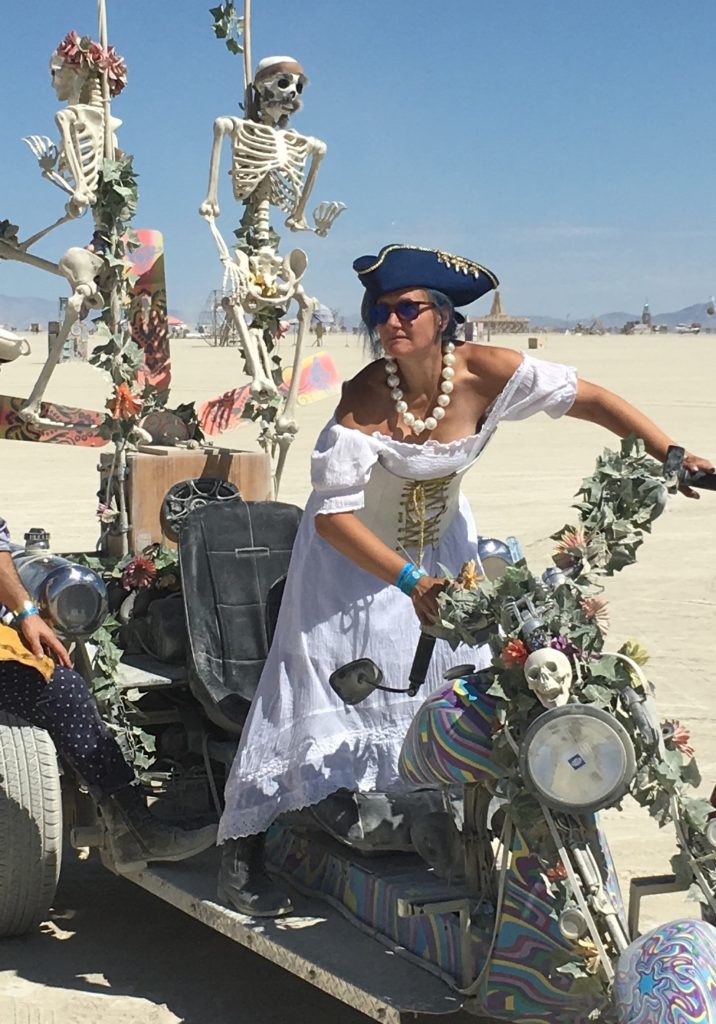 You need more fun & spontaneity in your life, and aren’t sure of next steps or the path to follow. Let’s connect! You could choose a free 15 minute chat, various courses, or even select one-to-one coaching.
You need more fun & spontaneity in your life, and aren’t sure of next steps or the path to follow. Let’s connect! You could choose a free 15 minute chat, various courses, or even select one-to-one coaching.



0 Comments